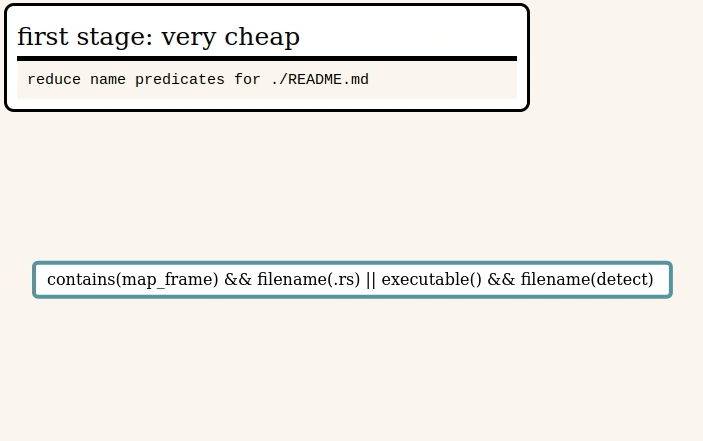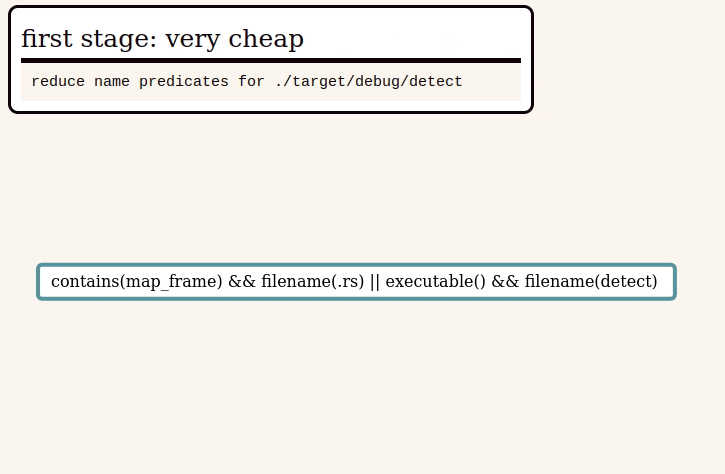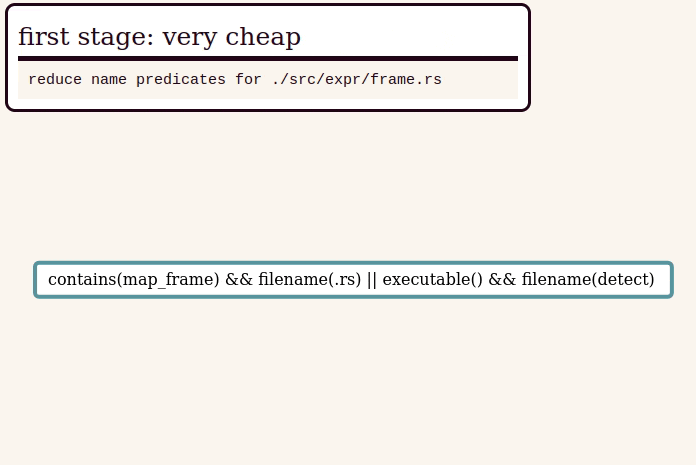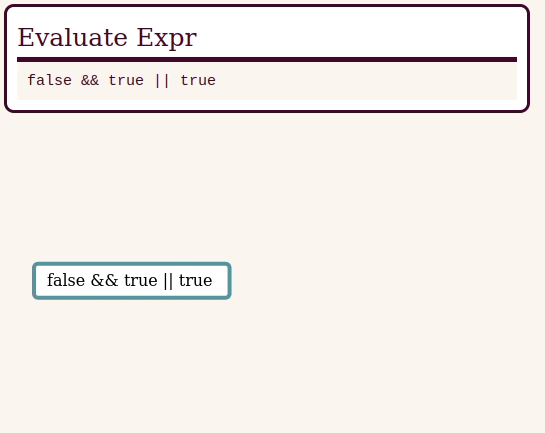In traditional low level languages such as C iteration is implemented manually, with users writing out for (int idx = 0; idx < items_len; ++idx) { do_thing(items[idx] }
, every time they want to iterate over a list. Newer languages like Rust provide abstractions - iterators - that separate the machinery of recursion from the logic: for item in items.iter() { do_thing(item) } .
The recursion crate does the same thing for recursive data structures. This post is an introduction to the new version of the recursion crate, but you don’t have to read my earlier posts to understand it.
Motivation: a file matching tool
I often use the find tool to find files matching some set of criteria - name, metadata, file contents, that kind of thing. Almost every time I use it for something nontrivial, I end up having to google the right combination of command line flags to express my query. For example, let’s say we want to list all files that fits one of the two following criteria:
- the file is executable and has ‘detect’ in its name
- the filename includes ‘.rs’ and the file contents include the string ‘map_frame’
While you can still express this query using find, due to the inherent constraints of the tools involved doing so is nontrivially complex.
{
# files executable by the current user, with "detect" in the filename
find . -type f -perm -u=x -name '*detect*'
# files with a ".rs" extension, containing the string "map_frame"
find . -type f -name "*.rs" -exec grep --files-with-matches map_frame '{}' ';'
} |
# remove duplicate entries
sort -u
(credit for this impressive bash hack: Josh Cheek)
Detect
That’s why I wrote detect. It’s like find, but instead of flags it uses an expression language with a series of predicates.
detect 'filename(detect) && executable() || filename(.rs) && contains(map_frame)'
Since some matching criteria are cheap and some are expensive, the detect tools is clever enough to run them in multiple stages - first filename criteria, then metadata criteria, and only then criteria that require looking at the full file contents. At each stage, it attempts to short circuit before running the next, more expensive, stage.
For the expression above, here are some visualizations of detect , as run against three different files in its own repository:
README.md: short circuits as false using only filename matcher
target/debug/detect: short circuits as true after reading metadata:
src/expr/frame.rs: evaluates to true after reading metadata and file contents
These GIFs show the process of running partial evaluation with short circuiting. Now we turn our eye to the implementation of this functionality.
Predicates
We evaluate expressions in three phases, and we have three types of predicate: Name, Metadata, and Content:
enum Predicate<Name, Metadata, Content> {
Name(Name),
Metadata(Metadata),
Content(Content),
}
The type parameters let us change the type of a Predicate to indicate what stage we’re on. As stages are eliminated we will use Done - an uninhabited type - to mark those branches as eliminated.
enum Done {}
Because Done is an enum with zero branches, it cannot exist at runtime. That means any branch of an enum containing it cannot exist either. For example, a Predicate<Done, Done, Content> can only contain Predicate::Content branches, because all the other branches are marked as uninhabited.
We will evaluate predicates by eliminating predicate type parameters to mark the evaluation of the corresponding phase, short circuiting where evaluation is possible:
enum ShortCircuit<A> {
Unknown<A>,
Known(bool),
}
impl<A, B> Predicate<NamePredicate, A, B> {
fn eval_name_predicate(self, filename: String)
-> ShortCircuit<Predicate<Done, A, B>> {}
}
impl<A> Predicate<Done, MetadataPredicate, B> {
fn eval_metadata_predicate(self, metadata: Metadata)
-> ShortCircuit<Predicate<Done, Done, B>> {}
}
impl Predicate<Done, Done, ContentPredicate> {
fn eval_content_predicate(self, contents: String)
-> ShortCircuit<Predicate<Done, Done, Done>> {}
}
At each stage, one type of predicate is eliminated as a possibility until none are left.
The expression language
The structure of the expression language is the same throughout each phase, with only the predicate type changing as we step through each phase.
enum Expr<Predicate> {
And(Box<Expr>, Box<Expr>),
Or(Box<Expr>, Box<Expr>),
Not(Box<Expr>),
Literal(bool),
Predicate(Predicate),
}
The core of detect is a function called reduce_and_short_circuit that shrinks the set of available predicates, short circuiting where possible and otherwise substituting in the predicate type for the next phase of evaluation.
// apply some potentially short circuiting transformation to all predicates in
// this expression, with the goal of eventually eliminating all predicate cases
fn reduce_and_short_circuit<A, B>(
&e: Expr<A>,
eval_predicate: impl Fn(A) -> ShortCircuit<B>,
) -> Expr<B> { /* etc */ }
Let’s see what the reduce_and_short_circuit function looks like, with and without the recursion crate.
The old ways
The traditional way to write this function is both hard to read and can cause a stack overflow if an expression is too deeply nested. Feel free to let your eyes slide over it - the nested matches, the &** invocations, the verbose recursive calls - terrible. We can do better.
pub fn reduce_and_short_circuit<A, B>(
&e: Expr<A>,
eval_predicate: impl Fn(A) -> ShortCircuit<B>,
) -> Expr<B> {
match self {
// Literal expressions are unchanged
Expr::Literal(x) => Expr::Literal(*x),
// apply 'f' to Predicate expressions
Expr::Predicate(p) => match eval_predicate(p.clone()) {
ShortCircuit::Known(bool) => Expr::Literal(bool),
ShortCircuit::Unknown(p) => Expr::Predicate(p),
},
// reduce And expressions
Expr::And(a, b) => match (&**a, &**b) {
(Expr::Literal(false), _) => Expr::Literal(false),
(_, Expr::Literal(false)) => Expr::Literal(false),
(x, Expr::Literal(true)) => x.reduce_and_short_circuit(eval_predicate),
(Expr::Literal(true), x) => x.reduce_and_short_circuit(eval_predicate),
(a, b) => Expr::And(
Box::new(a.reduce_and_short_circuit(&eval_predicate)),
Box::new(b.reduce_and_short_circuit(&eval_predicate)),
),
},
/* ...and so on for Or and Not */
}
}
A shiny new future
With the recursion crate, this can be simplified dramatically. The idioms used below (collapse_frames, the ExprFrame type) will be explained in this blog post, but you should be able to understand approximately what’s going on here by just skimming the function definition:
pub fn reduce_and_short_circuit<A, B>(
&e: Expr<A>,
eval_predicate: impl Fn(A) -> ShortCircuit<B>,
) -> Expr<B> {
self.collapse_frames(|e| match e {
// Literal expressions are unchanged
ExprFrame::Literal(x) => Expr::Literal(x),
// apply 'f' to Predicate expressions
ExprFrame::Predicate(p) => match eval_predicate(p) {
ShortCircuit::Known(b) => Expr::Literal(b),
ShortCircuit::Unknown(p) => Expr::Predicate(p),
},
// reduce And expressions
ExprFrame::And(Expr::Literal(false), _) => Expr::Literal(false),
ExprFrame::And(_, Expr::Literal(false)) => Expr::Literal(false),
ExprFrame::And(x, Expr::Literal(true)) => x,
ExprFrame::And(Expr::Literal(true), x) => x,
ExprFrame::And(a, b) => Expr::And(Box::new(a), Box::new(b)),
/* ...and so on for Or and Not */
})
}
Note that this is not just , it also more concise and easier to read, it does not use the call stack. The collapse_frames function uses an internal heap-allocated stack to manage the bookkeeping of recursion, and thus is not susceptible to call stack overflows.
How?
Let’s start with a simplified Expr type with no predicate param:
enum Expr {
And(Box<Expr>, Box<Expr>),
Or(Box<Expr>, Box<Expr>),
Not(Box<Expr>),
Literal(bool),
}
For working with our Expr type we’ll define a frame type ExprFrame<A>. It’s exactly the same as Expr, except the recursive self-reference Box<Self> is replaced with A. This may be a bit confusing at first, but this idiom unlocks a lot of potential (expressiveness, stack safety, etc). You can think of ExprFrame as representing a single stack frame in a recursive algorithm.
enum ExprFrame<A> {
And(A, A),
Or(A, A),
Not(A),
Literal(bool),
}
Now we define the relationship between Expr and ExprFrame. This requires us to implement two traits: MappableFrame and Collapsible. The actual implementation of these traits is fairly mechanical (and the details are discussed at more length in the docs), so feel free to skim:
impl MappableFrame for ExprFrame<PartiallyApplied> {
type Frame<X> = ExprFrame<X>;
fn map_frame<A, B>(input: Self::Frame<A>, mut f: impl FnMut(A) -> B) -> Self::Frame<B> {
match input {
ExprFrame::And(a, b) => ExprFrame::And(f(a), f(b)),
ExprFrame::Or(a, b) => ExprFrame::Or(f(a), f(b)),
ExprFrame::Not(a) => ExprFrame::Not(f(a)),
ExprFrame::Literal(x) => ExprFrame::Literal(x),
}
}
}
impl<'a> Collapsible for &'a Expr {
type FrameToken = ExprFrame<PartiallyApplied>;
fn into_frame(self) -> <Self::FrameToken as MappableFrame>::Frame<Self> {
match self {
Expr::And(a, b) => ExprFrame::And(a, b),
Expr::Or(a, b) => ExprFrame::Or(a, b),
Expr::Not(a) => ExprFrame::Not(a),
Expr::Literal(x) => ExprFrame::Literal(*x),
}
}
}
Generally speaking, you won’t use these traits yourself - they’re used by the internals of the recursion crate. The recursion crate docs contain full explanations of these traits, and how to implement them.
Writing Recursive Algorithms
The Collapsible trait provides the ability to write recursive algorithms that collapse some structure into a single value, frame by frame. Let’s look at an examples:
Evaluating simple expressions
Here’s what evaluating an Expr with collapse_frames looks like:
fn eval(e: &Expr) -> bool {
e.collapse_frames(|frame| match frame {
ExprFrame::And(a, b) => a && b,
ExprFrame::Or(a, b) => a || b,
ExprFrame::Not(a) => !a,
ExprFrame::Literal(x) => x,
})
}
Note that the function passed to collapse_frames only collapses a single frame of type ExprFrame<bool> - collapse_frames handles the rest.
Here’s a GIF showing each step in the evaluation of false && true || true using this function:
Conclusions
Use Recursion
The recursion crate is a perfect fit for working with recursive data structures. We’ve seen how it can used to implement a lazily evaluated expression language, and how expression languages can be a powerful tool for expressing arbitrary logic (for example, test filtering expressions in nextest are implemented using the recursion crate). Next time you’re developing a tool, consider providing users with an expression language - it’s easier than you might think.
The crate is here, docs are here, the github repository is here.
Use Detect
Detect is on crates.io. The most recent version of it supports multiple predicate stages (filename, file metadata, file contents, and even arbitrary subprocesses), and runs evaluation in multiple stages to minimize syscall use.
➜ cargo install detect
➜ detect 'filename(detect) && executable() || filename(.rs) && contains(map_frame)'
...
Generating Visualizations
All GIFs in this post were generated by a special instrumented version of the recursive machinery used by collapse_frames that automatically generates animated ‘stack traces’. Source code for this is here.
This is a great example of the kind of thing that you can do once you’ve separated the logic of recursion from the machinery.



